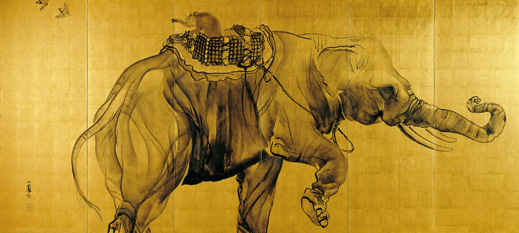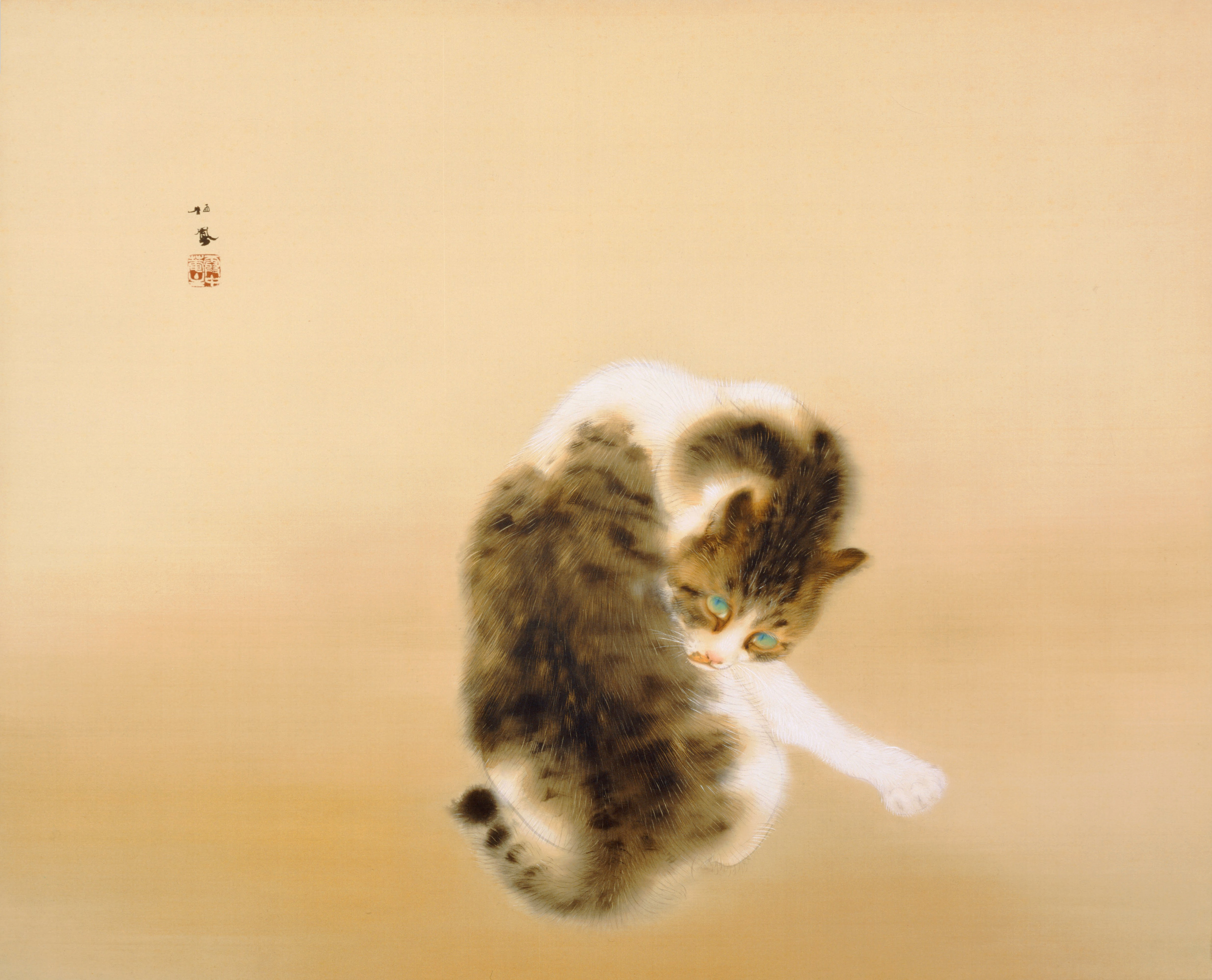Takeuchi Seihō on:
[Wikipedia]
[Google]
[Amazon]
(December 20, 1864 – August 23, 1942) was a Japanese painter of the ''


 Due to his travels in Europe, he was exposed to a number of western styles and ideas. Visiting Dresden Zoo, he was able to see a lion for the first time and painted it for one of his screens. Another work were two panels of elephants.
Later in his life he returned to more traditional Japanese motifs and painted smaller animals such as cats and fish.
*斑猫 (1924,
Due to his travels in Europe, he was exposed to a number of western styles and ideas. Visiting Dresden Zoo, he was able to see a lion for the first time and painted it for one of his screens. Another work were two panels of elephants.
Later in his life he returned to more traditional Japanese motifs and painted smaller animals such as cats and fish.
*斑猫 (1924,
Hakusasonsô (Hashimoto Kansetsu Museum)
*
Seiho's Cats
{{DEFAULTSORT:Takeuchi, Seiho 1864 births 1942 deaths 19th-century Japanese painters 20th-century Japanese painters Court painters Imperial household artists Kyoto City University of Arts alumni Nihonga painters Artists from Kyoto
Nihonga
''Nihonga'' (, "Japanese-style paintings") are Japanese paintings from about 1900 onwards that have been made in accordance with traditional Japanese artistic conventions, techniques and materials. While based on traditions over a thousand years ...
'' genre, active from the Meiji through the early Shōwa period
Shōwa may refer to:
* Hirohito (1901–1989), the 124th Emperor of Japan, known posthumously as Emperor Shōwa
* Showa Corporation, a Japanese suspension and shock manufacturer, affiliated with the Honda keiretsu
Japanese eras
* Jōwa (Heian ...
. One of the founders of ''nihonga'', his works spanned half a century and he was regarded as master of the prewar Kyoto
Kyoto (; Japanese: , ''Kyōto'' ), officially , is the capital city of Kyoto Prefecture in Japan. Located in the Kansai region on the island of Honshu, Kyoto forms a part of the Keihanshin metropolitan area along with Osaka and Kobe. , the ci ...
circle of painters. His real name was .
Biography
Seihō was born in Kyoto. As a child, he loved to draw and wanted to become an artist. He was a disciple ofKōno Bairei
was a Japanese painter, book illustrator, and art teacher. He was born (as Yasuda Bairei) and lived in Kyoto. He was a member of the broad Maruyama-Shijo school and was a master of kacho-e painting (depictions of birds and flowers) in the Meiji ...
of the Maruyama-Shijō school of traditional painting. In 1882, two of his works received awards at the ''Naikoku Kaiga Kyoshinkai'' (Domestic Painting Competition), one of the first modern painting competitions in Japan, which launched him on his career.
During the Exposition Universelle in Paris
Paris () is the capital and most populous city of France, with an estimated population of 2,165,423 residents in 2019 in an area of more than 105 km² (41 sq mi), making it the 30th most densely populated city in the world in 2020. S ...
(1900), he toured Europe
Europe is a large peninsula conventionally considered a continent in its own right because of its great physical size and the weight of its history and traditions. Europe is also considered a Continent#Subcontinents, subcontinent of Eurasia ...
, where he studied Western art. After returning to Japan he established a unique style, combining the realist techniques of the traditional Japanese Maruyama–Shijo school with Western forms of realism borrowed from the techniques of Turner
Turner may refer to:
People and fictional characters
*Turner (surname), a common surname, including a list of people and fictional characters with the name
* Turner (given name), a list of people with the given name
*One who uses a lathe for turni ...
and Corot
CoRoT (French: ; English: Convection, Rotation and planetary Transits) was a space telescope mission which operated from 2006 to 2013. The mission's two objectives were to search for extrasolar planets with short orbital periods, particularly th ...
. This subsequently became one of the principal styles of modern ''Nihonga''. His favorite subjects were animals -often in amusing poses, such as a monkey riding on a horse. He was also noted for his landscapes.
From the start of the ''Bunten
The is a Japanese art exhibition established in 1907. The exhibition consists of five art faculties: Japanese Style and Western Style Painting, Sculpture, Craft as Art, and Sho (calligraphy). During each exhibition, works of the great masters are ...
'' exhibitions in 1907, Seihō served on the judging committee. In 1909 he became a professor at the Kyoto Municipal College of Painting (the forerunner to the Kyoto City University of Arts
is a public, municipal university of general art and music in Kyoto, Japan. Established in 1880, it is Japan's oldest university of the arts (the predecessor of Tokyo University of the Arts was founded in 1887). Among its faculty and graduates ...
). Seihō also established his own private school, the ''Chikujokai''. Many of his students later went on to establish themselves as noted artists, including Tokuoka Shinsen and Uemura Shōen
was the pseudonym of an artist in Meiji, Taishō and early Shōwa period Japanese painting. Her real name was Uemura Tsune. Shōen was known primarily for her ''bijin-ga,'' or paintings of beautiful women, in the ''nihonga'' style, although sh ...
.
In 1913, Seihō was appointed as an Imperial Household Artist
An was an artist who was officially appointed by the Imperial Household Agency of Japan to create works of art for the Tokyo Imperial Palace and other imperial residences.
History
The system came into being during the Meiji period in 1890 and ...
, and in 1919 was nominated to the . He was one of the first persons to be awarded the Order of Culture
The is a Japanese order, established on February 11, 1937. The order has one class only, and may be awarded to men and women for contributions to Japan's art, literature, science, technology, or anything related to culture in general; recipien ...
when it was established in 1937.
He initially used the characters
Character or Characters may refer to:
Arts, entertainment, and media Literature
* ''Character'' (novel), a 1936 Dutch novel by Ferdinand Bordewijk
* ''Characters'' (Theophrastus), a classical Greek set of character sketches attributed to The ...
棲鳳 for the first name of his pseudonym, and this name was possibly pronounced as ''Saihō''.
Important works


 Due to his travels in Europe, he was exposed to a number of western styles and ideas. Visiting Dresden Zoo, he was able to see a lion for the first time and painted it for one of his screens. Another work were two panels of elephants.
Later in his life he returned to more traditional Japanese motifs and painted smaller animals such as cats and fish.
*斑猫 (1924,
Due to his travels in Europe, he was exposed to a number of western styles and ideas. Visiting Dresden Zoo, he was able to see a lion for the first time and painted it for one of his screens. Another work were two panels of elephants.
Later in his life he returned to more traditional Japanese motifs and painted smaller animals such as cats and fish.
*斑猫 (1924, Yamatane Museum
The Yamatane Museum (山種美術館, ''Yamatane Bijutsukan'') is a museum in Japan specializing in the nihonga style of Japanese watercolour painting
Watercolor (American English) or watercolour (British English; see spelling differences) ...
, Important Cultural Property)
*平家驚禽声逃亡 Tokyo National Museum
The or TNM is an art museum in Ueno Park in the Taitō ward of Tokyo, Japan. It is one of the four museums operated by the National Institutes for Cultural Heritage ( :ja:国立文化財機構), is considered the oldest national museum in Japan, ...
)
*秋興 (1927, Kyoto National Museum of Modern Art)
*絵になる最初 (1913, Kyoto Municipal Museum of Art
The is one of the oldest art museums in Japan. Nussbaum, Louis-Frédéric. (2005)"Museums"in ''Japan Encyclopedia'', pp. 671-673. It is located in Okazaki Park in Sakyō-ku, Kyoto, and opened in 1928 as a commemoration of Emperor Hirohito's coro ...
)
*薫風稚雀・寒汀白鷺 (1928, Museum of the Imperial Collections
The Museum of the Imperial Collections is located on the grounds of the East Garden of Tokyo Imperial Palace. It showcases a changing exhibition of a part of the imperial household treasures.
History
The Museum of the Imperial Collections was con ...
)
*群鵜 (1913, Kachu'an Takeuchi Seiho Memorial Gallery)
*アレ夕立に (1909, Takashimaya Archives)
*雨霽 (1907, Tokyo National Museum of Modern Art
The in Tokyo, Japan, is the foremost museum collecting and exhibiting modern Japanese art.
This Tokyo museum is also known by the English acronym MOMAT (National Museum of Modern Art, Tokyo). The museum is known for its collection of 20th-centu ...
)
Notable pupils
*Tsuchida Bakusen
was the art-name of a Japanese painter in the ''Nihonga'' style, active during the Taishō and early Shōwa eras. His birth name was .
Biography
He was born on Sado island in Niigata Prefecture into a wealthy and influential family. His you ...
* Ono Chikkyō
* (西村五雲)
*Hashimoto Kansetsu
Hashimoto Kansetsu (, November 10, 1883 – February 26, 1945) was a painter of nihonga (Japanese-style paintings) who was active in the Kyoto art world during the Showa and Taisho eras.
Born in Kobe, he was the son of the painter Hashimoto Ka ...
(橋本関雪)*
Uemura Shōen
was the pseudonym of an artist in Meiji, Taishō and early Shōwa period Japanese painting. Her real name was Uemura Tsune. Shōen was known primarily for her ''bijin-ga,'' or paintings of beautiful women, in the ''nihonga'' style, although sh ...
*Nishiyama Suisho
was a Japanese painter.
Early life
Nishiyama Suishō was born "Nishiyama Usaburo" in Kyoto in 1879. He studied with Takeuchi Seihō (1864-1942), a famous painter from Kyoto. In 1915, he married Takeuchi Tei, one of his master's daughters.
Care ...
See also
*Seison Maeda
was the art-name of a nihonga painter in the Taishō and Shōwa periods of Japan. His legal name was Maeda Renzō. He is considered one of the greatest contemporary Japanese painters, and one of the leaders of the Nihonga movement.
Biography
...
(1885–1977), one of the leading ''Nihonga'' painters
* List of Nihonga painters
This is an alphabetical list of painters who are known for painting in the ''Nihonga'' style. It has to be noted that some artists also painted in the western ''Yōga'' style, and that the division between the two groups could be blurred at poin ...
References
* Hirota, Takashi. ''Takeuchi Seiho: Kindai Nihonga no genryu''. Shibunkaku ShuppanExternal links
Seiho's Cats
{{DEFAULTSORT:Takeuchi, Seiho 1864 births 1942 deaths 19th-century Japanese painters 20th-century Japanese painters Court painters Imperial household artists Kyoto City University of Arts alumni Nihonga painters Artists from Kyoto